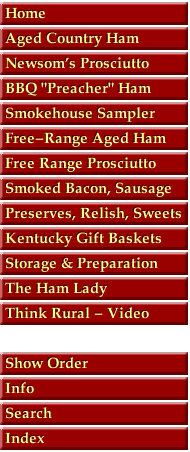
 by Stuart Englert Smoking remains a popular way to flavor and preserve food. Nancy Newsom Mahaffey, 57, of Princeton, Kentucky, uses a centuries-old family recipe to produce Col. Bill Newsom’s Aged Kentucky Country Ham, preserving a meat-curing method used by her father Bill Newsom, grandfather H.C. Newsom, and English ancestors who settled in Surry County, Virginia, in 1635. “You don’t want to cook the ham,” says Mahaffey, nicknamed The Ham Lady. “I build a small fire that bathes the hams in cool smoke from top to bottom.” Each winter, hams are hand-rubbed with salt and brown sugar to flavor the meat and extract moisture. After a month, the salt-inoculated hams are washed and hung in the smokehouse. On a cool, damp spring day, a smoldering fire is lit and the hams are smoked for several weeks, giving them an amber color and distinct smoky flavor. “Curing and smoking are an art form,” says Mahaffey, who monitors humidity and temperature inside the concrete-block building during the smoking and aging process. “Usually my last smoking occurs on a cool day in June,” Mahaffey adds. “I don’t sell the hams until they’re at least 10 months old.” Food preservation Humans have smoked meat since prehistoric times, discovering that exposure to a smoldering fire dried and flavored animal flesh. Centuries before refrigeration and the canning process were developed, people salted and smoked fish and meat to prevent spoilage, to repel insects, and to preserve food for winter and lean times. In Colonial America, nearly every farm with pigs had a smokehouse to cure and store bacon and hams, and during the 19th century, commercial smokehouses processed boatloads of herring and sardines in coastal fishing villages such as Lubec, Maine. Virginia has the largest concentration of historical smokehouses, with reconstructed meat-curing structures at George Washington’s Mount Vernon Estate, Thomas Jefferson’s Monticello in Charlottesville, and Patrick Henry’s Red Hill in Brookneal. Of the 88 original structures at Colonial Williamsburg, Virginia, 10 are smokehouses dating to the 18th and 19th centuries. “The smokehouses were used to preserve pork,” says Frank Clark, 48, supervisor of the Department of Historic Foodways for the Colonial Williamsburg Foundation. “Pork was a staple in the diet.” Each December, Clark and a team of historic interpreters demonstrate how English colonists butchered hogs and salted hams prior to smoking in the Governor’s Palace smokehouse at Colonial Williamsburg, the world’s largest living history museum. Taste that smoke While smokehouses aren’t as prevalent in the United States as they used to be, smoking remains a popular way to flavor and preserve food. Thousands of smokehouses—from small backyard sheds to large commercial facilities—dot the nation, producing tons of smoked cheese, pork, poultry, sausage, seafood and wild game. “Whatever food you smoke will develop a smoky flavor,” says Stanley Marianski, 65, author of “Meat Smoking and Smokehouse Design,” noting that wood from fruit and nut-bearing trees—apple, cherry, hickory, oak and pecan—provide the best results. “Any hardwood is fine for smoking,” adds Marianski, of Seminole, Florida. “You shouldn’t smoke with softwood such as fir or pine because they contain a lot of resin.” In Alaska, salmon and reindeer sausage is smoked with alder or birch wood, and in New England, smoldering corncobs flavor bacon, ham, sausage and turkeys. “Frequently we cure the meat with maple syrup and then smoke it with corncobs. It’s a very good combination,” says Sam Cutting IV, 54, owner of Dakin Farm in Ferrisburgh, Vermont. “Corncobs produce a sweet, delicate flavor that’s not as pungent as hardwood.” In the Catskill Mountains, Waldemar Kozik, 54, carries on the tradition of his ancestors by smoking Polish kielbasas (sausages) and fish in a backyard kiln that he and a friend built at a family retreat near Glen Spey, New York. “I never go to the store to buy gifts,” Kozik says. “I give my sausage and smoked meats to friends for Christmas presents.” Age-old tradition The holiday season is the busiest time of the year for commercial smokehouses. In Kentucky, Mahaffey sells most of her hams at Newsom’s Old Mill Store or via mail order in November and December. Customers have been buying Newsom’s smoked country hams for their Thanksgiving dinners and as Christmas gifts for generations. “One of the finest things I’ve ever laid on my tongue,” says Randy Oehmig, 70, of Crystal River, Florida, describing the smoked ham that his family has savored for 50 years. “The combination of the smoky flavor and saltiness is almost indescribable.” In the early 1960s, Oehmig’s father Von and his three brothers went on a “ham hunt,” searching the nation for the best salt-cured country ham. After a few years, they settled upon Col. Bill Newsom’s Aged Kentucky Country Ham and the Oehmig family has ordered the smoky delicacy for holiday meals and gifts ever since. “A lot of what we like to eat is from our heritage,” says Mahaffey, who built a smoldering fire in a newly built smokehouse in Princeton, Kentucky, this spring, preserving a culinary art and an age-old family tradition. Secure meat storage Once common in the United States, smokehouses were built of brick, logs, lumber or stone, and used to store meat after completion of the smoking process. Smokehouses often were padlocked to deter thieves. American Profile Magazine, November 2, 2013 |